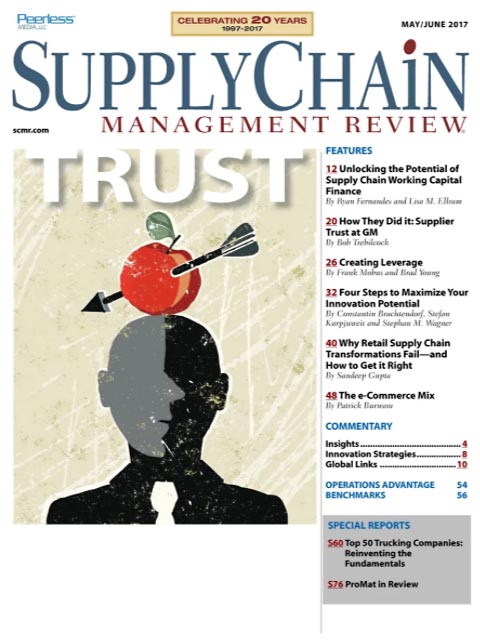Sorry, but your login has failed. Please recheck your login information and resubmit. If your subscription has expired, renew here.
May-June 2017
Trust hasn’t always been an element in supplier relationships; all too often buyers have been encouraged to carry a big stick and get tough with suppliers to get the best price—no matter the cost. That approach to procurement is beginning to change. Browse this issue archive.Need Help? Contact customer service 847-559-7581 More options
Humb through the pages of any business—or supply chain—journal and you won’t look long before you stumble across the word transformation. Business professionals across the world are in love with the word as well as the idea of transforming their organizations to tackle the challenges confronting their businesses and put a cloud of dust between them and their competitors. It’s part of the daily business spiel, tossed around in the boardroom and C-suite; in consultants’ presentations; at management conferences; and in the pages of Supply Chain Management Review. But if we ask those same executives just what the word transformation means to them, there would likely be little if any consensus on its definition or how it applies to their organizations or supply chains.
For the purposes of this article, we’ll use the definition that comes up in most searches, which is that transformation is the process of driving fundamental and sustainable change. Those two key words are crucial. Businesses around the world are experiencing never-ending transformations caused by a number of trends at play, including but not limited to the following:
- customer demands for customization and quality at the lowest cost, shifts to services, all leading to ever-evolving business models like omni-channel;
- life-cycle compression, which isn’t limited to just the ever-shortening life-cycle of products (an article last year in Forbes noted that as recently as 50 years ago, the life expectancy of a firm in the Fortune 500 was around 75 years; now it is compressed to less than 15 years and declining even further;)
- intense, global competition driven by players like Amazon, Uber and Alibaba that are changing the rules of the game through their ever-evolving business models,
- disruptive forces such as the Internet of Things (IoT), 3-D Printing, Artificial Intelligence, Robotics Process Automation and even visionary political and business leaders who are creating Smart Cities in places such as Dubai and Singapore.

This complete article is available to subscribers only.
Log in now for full access or start your PLUS+ subscription for instant access.
SC
MR
Sorry, but your login has failed. Please recheck your login information and resubmit. If your subscription has expired, renew here.
May-June 2017
Trust hasn’t always been an element in supplier relationships; all too often buyers have been encouraged to carry a big stick and get tough with suppliers to get the best price—no matter the cost. That approach to… Browse this issue archive. Access your online digital edition. Download a PDF file of the May-June 2017 issue.Humb through the pages of any business—or supply chain—journal and you won't look long before you stumble across the word transformation. Business professionals across the world are in love with the word as well as the idea of transforming their organizations to tackle the challenges confronting their businesses and put a cloud of dust between them and their competitors. It's part of the daily business spiel, tossed around in the boardroom and C-suite; in consultants' presentations; at management conferences; and in the pages of Supply Chain Management Review. But if we ask those same executives just what the word transformation means to them, there would likely be little if any consensus on its definition or how it applies to their organizations or supply chains.
For the purposes of this article, we'll use the definition that comes up in most searches, which is that transformation is the process of driving fundamental and sustainable change. Those two key words are crucial. Businesses around the world are experiencing never-ending transformations caused by a number of trends at play, including but not limited to the following:
- customer demands for customization and quality at the lowest cost, shifts to services, all leading to ever-evolving business models like omni-channel;
- life-cycle compression, which isn't limited to just the ever-shortening life-cycle of products (an article last year in Forbes noted that as recently as 50 years ago, the life expectancy of a firm in the Fortune 500 was around 75 years; now it is compressed to less than 15 years and declining even further;)
- intense, global competition driven by players like Amazon, Uber and Alibaba that are changing the rules of the game through their ever-evolving business models,
- disruptive forces such as the Internet of Things (IoT), 3-D Printing, Artificial Intelligence, Robotics Process Automation and even visionary political and business leaders who are creating Smart Cities in places such as Dubai and Singapore.
SC
MR


Latest Supply Chain News
- How S&OP provides the answer to in-demand products
- AI, virtual reality is bringing experiential learning into the modern age
- Humanoid robots’ place in an intralogistics smart robot strategy
- Tips for CIOs to overcome technology talent acquisition troubles
- There is still work to do to achieve supply chain stability
- More News
Latest Podcast

 Explore
Explore
Latest Supply Chain News
- How S&OP provides the answer to in-demand products
- AI, virtual reality is bringing experiential learning into the modern age
- Humanoid robots’ place in an intralogistics smart robot strategy
- Tips for CIOs to overcome technology talent acquisition troubles
- There is still work to do to achieve supply chain stability
- Blooming success: The vital role of S&OE in nurturing global supply chains
- More latest news
Latest Resources

Subscribe

Supply Chain Management Review delivers the best industry content.

Editors’ Picks





